Spektator. Jaargang 3
(1973-1974)– [tijdschrift] Spektator. Tijdschrift voor Neerlandistiek–
[pagina 69]
| |||||||||||||||||||||||||||||||||||||||||||||||||||||||||||||||||||||||||||||||||||||||||||||||||||||||||||||||||||||||||||||||||||||||||||||||||
Arn. Evers
| |||||||||||||||||||||||||||||||||||||||||||||||||||||||||||||||||||||||||||||||||||||||||||||||||||||||||||||||||||||||||||||||||||||||||||||||||
| Zij wilde sprinten. |
| Zij probeerde te sprinten. |
Het kan worden aangetoond dat de onderliggende struktuur van zulke zinnen verschilt van de oppervlaktestruktuur. Er moeten dus transformaties op hebben gewerkt. Eén daarvan is de in de titel genoemde Predicate Raising. Het effekt daarvan is o.m. dat de struktuur van de zin een S-knoop verliest, en dus minder ‘samengesteld’ wordt. In de resulterende struktuur vormen persoonsvorm en infinitief één geheel.
Even belangrijk is de transformatie Extrapositie, waarbij geen S-knoop verloren gaat. Het verschillend effekt van deze twee regels is af te lezen in bijzinnen. De eerste hieronder is afgeleid met behulp van o.a. Predicate Raising, de tweede met Extrapositie.
| ...omdat Jan zijn sabel probeerde te poetsen. |
| ...omdat Jan probeerde zijn sabel te poetsen. |
Ook in het Duits bestaan deze transformaties, maar PR heeft in die taal een zodanige werking dat zich, bij vergelijking met onze taal, een zeker spiegel-effekt voordoet: probeerde te poetsen vs. zu putzen versuchte.
De naam Predicate Raising is ontleend aan een door de generatieve semantici voorgestelde transformatie. Er wordt hieronder echter betoogd dat de twee regels niet met elkaar kunnen worden geïdentificeerd, aangezien de hier voorgestelde regel wel aan de eisen voor een transformatie zou voldoen en de door de generatieve semantici voorgestelde regel niet. (Red.)
0. Introduction
Predicate Raising was introduced into English grammar for the sake of generative semantics (Mc Cawley '68; see also Lakoff '65, IV 11 and 17). The grammar of English offers little syntactic evidence for Predicate Raising (Chomsky '70, 22). One might wonder whether this is due to some inherent fallacy of the rule or to a peculiarity of the grammar of English. The first objective of this paper is to settle that issue by showing that Predicate Raising is a fully warranted rule in the syntax of Dutch and German. An extensive set of Dutch and German sentences needs a deep structure of type (1a), see section 2, and a surface structure of type (1b), see section 1.Ga naar eind1.

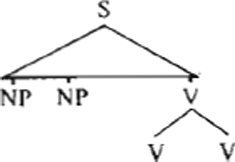
Structure (1a) is needed for the proper working of
| S - pronominalization | (section 2.1) |
| Selection Restrictions | (section 2.2) |
| Passive | (section 2.3) |
| Nuclear Stress | (section 2.4) |
Structure (1b) is needed to ensure the proper working of
| Gapping | (section 1.1) |
| Nominalization | (section 1.2) |
| Extraposition | (section 1.3) |
| Clitic Placement | (section 1.4) |
| Quantifier Hopping | (section 1.5) |
The transition from (1a) to (1b) is provided by Predicate Raising. This transformation may be governed by nearly all verbs with a tenseless sentential subject or object and must be considered as the key to the grammar of Dutch-German predicate complements
Dutch-German Predicate Raising is of immediate relevance for a number of theoretical issues (section 4). It demonstrates that transformations are tree-changing rather than string-changing operations (section 4.1), that the theory of syntax should allow S-pruning (section 4.2), that there are no universal syntactic phenomena to define the feature <+aux > (section 4.3), that transformations are not necessarily structure preserving (section 4.4), and last but not least, that the rule probably can not be used for cases of lexical decomposition (section 4.5).
1. Surface structure (1b).
1.1. Gapping
A simple example of Gapping is (2).
..., weil Johann das Lied anstimmt und Cecilia die Arie  . . |
| ‘because J. begins the song and C. the aria’ |
The identical constituent V is dropped in the second half of the conjunction.Ga naar eind2. More elaborate structures are (3) and (4).
| (3) | *..., weil Johann [Gedichte zu schreiben beginnen]L will
und Cecilia [Arien anstimmen dürfen]L will. |
| (4) | ..., weil Johann [Gedichte schaffen können]L will
und Cecilia [Arien schaffen können]L will. ‘because J. wants to begin to write poetry and C. wants to be allowed to start aria's’ ‘because J. wants to be able to create poetry and C. wants to be able to create aria's. |
If an object constituent like the one labelled L were present, one would
sooner expect a Gapping like (3) than a Gapping like (4). Nevertheless (4) is grammatical, while (3) is not. The same rule of Gapping may generate (2) and (4) and exclude (3), if we postulate (5) and apply an A over A principle.

Gapping belongs to a level of analysis at which the verbs at the end of the construction are united into one constituent.Ga naar eind3. I.e., it requires a structure of type (1b) and is incompatible with a structure of type (1a).
1.2. Nominalization
A few examples of the kind of Nominalization that we have in mind are (6), (7) and (8). The key fact is that the object constituent must follow the nominalized infinitive. Sentential objects as in (7) and (8) shift to the right without further change, just as if Extraposition had applied. A noun object as in (6) shifts to the right and takes the genitive case.
| (6a) | Dass er ein Segelschiff entwirft, begeistert uns. |
| (6b) | Sein Entwerfen des Segelschiffes begeistert uns. |
| (6c) | *Sein das Segelschiff Entwerfen begeistert uns.
‘that he designs/his designing a sailboat makes us enthousiastic’ |
| (7a) | Dass sie behauptet dass er nie zurück kommen werde, stimmt nicht. |
| (7b) | Ihr Behaupten dass er nie zurück kommen werde stimmt nicht. |
| (7c) | *Ihr dass er nie zurück kommen werde Behaupten stimmt nicht.
‘that she claims/her claiming that he will never return, does not agree’ |
| (8a) | Dass er zögert um Kap Horn herum zu segeln, ist verständlich. |
| (8b) | Sein Zögern um Kap Horn herum zu segeln ist verständlich. |
| (8c) | *Sein um Kap Horn herum zu segeln Zögern ist verständlich.
‘that he hesitates/his hesitating to round Cape Horn is understandable’ |
A more elaborate structure is (9).
| (9a) | Dass er [das Segelschiff entwerfen lassen]L darf, begeistert uns. |
If there were an object constituent like the one labelled L, one would sooner expect (9d) than (9b). However (9b) is grammatical, while (9d) is not.
| (9b) | Sein Entwerfen-lassen-dürfen des Segelschiffes begeistert uns. |
| (9c) | *Sein [das Segelschiff entwerfen lassen]L Dürfen begeistert uns. |
| (9d) | *Sein Dürfen [das Segelschiff entwerfen lassen]L begeistert uns.
‘that he may/his being permitted to have a sailboat designed makes us enthousiastic’ |
We may exclude the ungrammatical variants and generate the grammatical ones when we postulate a structure like (10) and apply an A over A principle.

Nominalization of structure (9) demonstrates that all verbs at the end of the construction are united into one constituent, while the object of the most embedded verb functions as object of the construction as a whole. The conclusion is that a possible deep structure of type (1a) should have been transformed into a structure of type (1b) before Nominalization applies.
1.3. Extraposition
The two arguments given so far were of a strong type. They offered direct evidence for a structure such as (1b). The arguments in this and the next two sections are weaker. They only prove that there is a level of analysis which is incompatible with a structure of type (1a). To be more specific, they refute an analysis as indicated in (11a) and (11b).
| (11a) | ..., weil wir [Peter die Geschichte erzählen]S hörten. |
| (11b) | ..., weil wir Peter [die Geschichte erzählen]S/VP hörten.
‘because we heard Peter tell the story’ |
Our first argument of this type, the rule of Extraposition, proves the untenability of (11) in two ways.
Ross pointed out that an internal S tends to make a sentence unacceptable (Ross '67, 33). His examples have straightforward parallels in Dutch and German. The analysis in (11) might have fitted this pattern if (11) had turned out to be a rather strained construction in need of improvement by Extraposition. But (11) is completely natural, whereas Extraposition changes the construction into the ungrammatical
| (12) | *..., weil wir [ ] hörten [Peter die Geschichte erzählen] S. |
From a standpoint of English transformational grammar one is likely to come up with the objection that [ Peter] NP was raised. Extraposition, applied later on, should only refer to [die Geschichte erzählen] S/VP. This objection is refuted by the ungrammaticality of (13) versus the grammaticality of (14).
| (13) | *..., weil wir Peter [ ] hörten [die Geschichte erzählen]S/VP |
| (14) | ..., weil wir Peter [ ] halfen [die Geschichte zu erzählen]S/VP |
If (11a) or (11b) were true, one could not explain why Extraposition is blocked for the complement of hören. Consequently an analysis like (11a) or (11b) is not valid at the level of analysis relevant tot Extraposition.
There is a second way to use Extraposition as an objection against analysis (11). We arrive at the awkward (15a) and the ungrammatical (16a) when [die Geschichte]NP is substituted respectively by
| [das Lied dass alle Menschen Brüder werden]NP |
| [dass alle Menschen Brüder werden]S |
| (15a) | weil wir Peter [das Lied dass alle Menschen Brüder werden]NP singen hörten |
| (16a) | *weil wir Peter [dass alle Menschen Brüder werden]S singen hörten. |
The ungrammaticality of (16a) is caused by the internal S (Ross '67, 33). Suppose that analysis (11) were true and that we tried to improve (15a) and (16a) by applying respectively Extraposition from NP and Extraposition. The results couldn't have been worse.
| (15b) | ** weil wir Peter das Lied [ ] singen [dass alle Menschen Brüder werden]S hörten. |
| (16b) | ** weil wir Peter [ ] singen [dass alle Menschen Brüder werden]S hörten. |
Completely natural, however, are
| (15c) | weil wir Peter das Lied [ ] singen hörten [dass alle Menschen Brüder werden]S |
| (16c) | weil wir Peter [ ] singen hörten [dass alle Menschen Brüder werden]S |
Because Extraposition from NP and Extraposition are upward bounded, it is impossible for them to bring constituents outside an S or VP-labelled structure.
| (17) | ...[...[ dass alle Menschen Brüder werden ]S singen ] S/VP hörten |
In view of the grammaticality of (15c) and (16c) the conclusion must be that the complement of hören cannot have an S- or VP-character at the level relevant to Extraposition.
1.4 Clitic Placement
German and Dutch have a rule of Clitic Placement. The situation in Dutch is but only slightly different from the picture in English. In both languages it is possible to delete the preposition of the dative object after Dative Movement.
| (18a) | we gave | a racing bike to our friend.
our friend a racing bike. *a racing bike our friend. |
| (19a) | we gaven | een racefiets aan onze vriend.
onze vriend een racefiets. *een racefiets onze vriend. |
Dative Movement over a pronominal object results, for both languages, in an ungrammatical string.
| (18b) | *We gave our friend it. |
| (19b) | *We gaven onze vriend het. |
At this point the situation becomes static in English. Ungrammatical (18b) has to be rejected by an output constraint. In Dutch there is a more dynamic solution in Clitic Placement. This rule obviously does not work in English.
| (18c) | *We gave it our friend. |
| (19c) | We gaven het onze vriend. |
The German dative object has no prepositional variant. Its place is to the left of the direct object. If this direct object is a pronoun, Clitic Placement seems a reasonable hypothesis.
| (20a) | wir gaben unserem Freund ein Rennrad.
das Rennrad unserem Freund. |
|
| (20b) | *wir gaben | unserem Freund es
das Rennrad ihm. |
| (20c) | wir gaben | es unserem Freund.
ihm das Rennrad. |
The rule of Clitic Placement is clearly upward bounded. See (21).
| (21a) | wir spornten Johann an [es unserem Freund zu geben] S/VP |
| (21b) | *wir spornten es Johann an [unserem Freund zu geben] S/VP |
| ‘we urged J. to give it our friend’ |
However, when we replace anspornen ‘to urge’ by lehren ‘to teach’ or by sehen ‘to see’, we arrive at the perfectly grammatical forms of (22) and (23).
| (22) | wir lehren es Johann [ singen]L |
| ‘we teach J. to sing it’ | |
| (23) | wir sahen es [Johann unserem Freund geben]L |
| ‘we saw J. give it to our friend’ |
The clitics in (22) and (23) leave the L-constituent. Consequently the label L, if indicating a constituent at all, cannot be an S or a VP. Q.e.d.
1.5. Quantifier Hopping
The following pairs have to be explained by a transformation of Quantifier Hopping.
| (24a) | wir alle erzählten die Geschichte unserer Freundin. |
| (24b) | wir erzählten die Geschichte alle unserer Freundin. |
| ‘we all told the story to our girlfriend.’ |
This transformation is certainly downward bounded.Ga naar eind4.
| (25a) | wir rieten alle an [die Geschichte unserer Freundin zu erzählen] S/VP |
| (25b) | *wir rieten an [die Geschichte alle unserer Freundin zu erzählen]S/VP |
| ‘we all advised to tell the story to our girlfriend’ |
However, if we substitute hören ‘to hear’ for anraten ‘to advise’ we arrive at the grammatical form (26).
| (26) | wir hörten [die Geschichte alle unserer Freundin erzählen]L |
| ‘we all heard (someone) tell the story to our girlfriend’ |
Even stronger cases are (27) and (28).
| (27) |
 |
| (28) |
 |
The keyfacts of this argument against (11) are (25) and (26).
Example (25) demonstrates that Quantifier Hopping is downward bounded.
Example (26) shows that the complement of hören cannot stop a hopping quantifier. This indicates that the L in (26) (27) and (28), if labelling a constituent at all, cannot be an S or a VP. Like Clitic Placement, Quantifier Hopping is incompatible with a structure of type (1a). The reader should realize that the examples in this section belong to the spoken rather than to the written language.
2. Deep structure (1a)
The five rules mentioned in the preceding sections all show that our examples must permit, at a certain moment, an analysis which is incompatible with a structure of type (1a). Two of these rules, Gapping and Nominalization, sustain in addition the positive claim that the Dutch-German verb row must be one constituent, i.e. they sustain the claim made in structure (1b).
In the following sections we will sketch four rules which demonstrate that the same examples must also permit a level of analysis identical with structure (1a) and incompatible with structure (1b).
2.1. S-pronominalization
In Dutch and German it is possible to pronominalize complement S-structures by het ‘it’ respectively es. Our first argument in support of deep structure (1a) is S-pronominalization.Ga naar eind5. See (29), (30) and (31).
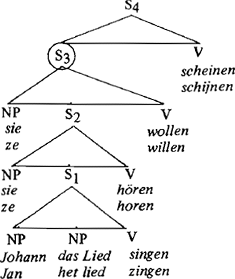
‘they seem to want to hear John sing the song’

| (31) | weil sie Johann das Lied singen hören zu wollen scheinen..., |
| (31a) | ...scheinst du es nicht hören zu wollen. |
| (31b) | ...scheinst du es nicht zu wollen. |
| (31c) | *scheinst es nicht |
Looking at diagram (29) we may say that
| (31a) | pronominalizes the S1 structure on the grounds of simple identity, |
| (31b) | pronominalizes the S2 structure on the grounds of sloppy identity, |
| (31c) | tries to pronominalize the S3 but does not succeed, since there is no identity, sloppy or otherwise. |
Positive evidence for the deep structure constituent S3 can be derived from (32), where the complement of scheinen functions as the antecedent of the pronoun.
| (32a) | weil Johann die Arie nur zu singen scheint wenn Cecilia ihn dazu auffordert. ‘because J. seems to sing the aria only if C. challenges him to (it) / challenges him to do so’ |

One would expect pronominalization of the complement of scheinen after Y - movement of the adverbial sentence. However (33) turns out to be ungrammatical.
| (33) | *wenn Cecilia Johann dazu aufforderte die Arie zu singen, schien es.
‘when C. challenged J. to sing the aria, it seemed’ |
It seems that scheinen asks for a surface structure in which at least the verbal remnants of a complement are present. I cannot explain this but hope that an eventual solution will not be fatal to the hypothesis that scheinen has an S-complement in its deep structure.
Diagram (30) offers no basis for the explanation of S-pronominalization. The claim inherent in (30) is exactly that the antecedents of the pronouns are ‘destroyed’ at surface level. This becomes strikingly clear in the Dutch order of infinitives, but has also been proved for German if all verbs in (30) really form one constituent.
2.2. Selection Restrictions
In order to state the rules for Selection Restriction, Passive and Nuclear Stress in a non ad hoc way it is essential that the structures show in a uniform way whether the main verb is transitive of not. This condition is fulfilled in the (a) structures but not in the (b) structures of (34), (35), (36) and (37).
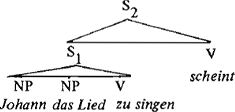
‘J. seems to sing the song’
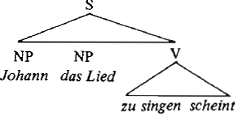
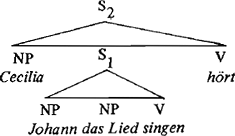
‘C. hears J. sing the song’

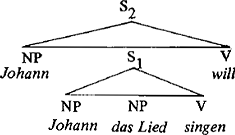
‘J. wants to sing the song’
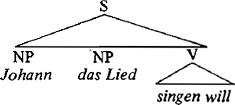
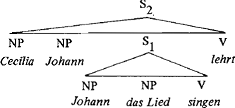
‘C. teaches J. to sing the song’

Two NP's to the left are necessary to insert a transitive main verb like singen in a structure like (34b) or (36b), whereas three NP's to the left are necessary to insert such a verb in (35b) or (37b). Something like this holds for the intransitives as well. Insertion of an intransitive requires one NP to
the left in (34b) and (36b), but two NP's to the left in (35b) and (37b). Hence, if we were to take the (b) structures as basis for lexical insertion, the number of insertion rules would double. The choice of the insertion rule would depend on the kind of ‘companion’ verb. E.g. scheinen and wollen on the one hand, hören and lehren on the other.
The (a) structures permit the statement of the insertion rules in a uniform way, without reference to irrelevant ‘companion’ verbs.
2.3. Passive
If Passive were to be defined on the (b) structures, it would be impossible to recognize it as one phenomenon. The structural description would have to discriminate between four cases.
| (i) | In the first case there are no ‘companion’ verbs unless they belong to the class of scheinen or to the class of the auxiliaries:
Passive is possible if there are two NP's. |
| (ii) | there is a companion verb of the type of hören:
Passive is possible if there are three NP's. |
| (iii) | there is a companion verb of the type wollen, hoffen, glauben:
Passive is possible if there are two NP's, but causes unprecedented changes in meaning. E.g. (38) (38a) Johann will Cecilia bewundern. (38b) Cecilia will von Johann bewundert werden. ‘John wants to admire Cecilia/ C. wants to be admired by J.’ |
| (iv) | there is a companion verb like lehren:
Passive is not possible. |
None of these problems arise if we define Passive on the (a) structures. An independently needed deep structure constraint which requires that the complement of lehren be <-stative> excludes a Passive in (37a).
2.4. Nuclear Stress
The argument based on Nuclear Stress was discovered by Huybregts (Huybregts '72). The neutral sentence stress in (34), (35), (36) and (37) is invariably on [das Lied] NP. Because [ singen ] V is a pseudotransitive, it is possible to leave out the object [ das Lied] NP. The stress is then invariably on the intransitive [ singen ] V. The more complex structures simply hold the neutral stress pattern of the most embedded S in the (a) structures.
| (39a) | weil Johann das Lied singt. |
| (39b) | weil Johann singt. |
Nuclear stress can only be a revealing rule if it is allowed to refer to the (a) structures. This is strikingly confirmed by an ambiguous string in Dutch.
| (40) | omdat we Benedictine leren drinken
‘because we learn to drink Benedictine (kind of liqueur)’ ‘because we teach Benedictine (a girl) to drink’ |
The ambiguïty rests on three lexical factors
Benedictine: girlsname / kind of liqueur
leren: + causative teach / - causative learn
drinken: transitive /intransitive
The respective deep structures are
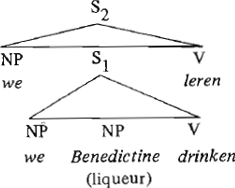
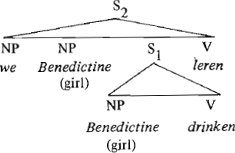
The difference of the S1 structures in (40a) and (40b) causes a difference in neutral stress. The terminal string belonging to (40a) gets its neutral stress on [Benedictine]NP, and the terminal string belonging to (40b) on [drinken]V. It is an elegant example of neutral sentence stress as a deep structure clue. The respective surface structures are (41a) and (41b)Ga naar eind6.
| (41a) omdat wij [Benedictine]NP [leren drinken]V (liqueur) |
| (41b) omdat wij [Benedictine]NP [leren drinken]V (girl). |
3. Predicate Raising
3.1. Survey of arguments
| (i) | The existence of an underlying structure (1a) is established for certain examples by four independent arguments. |
| (ii) | Because (1a) was partly motivated by lexical insertion rules, we may identify it as the deep structure of our examples. |
| (iii) | The same examples showed an underlying structure (1b) supported by five independent syntactic arguments. |
| (iv) | The translation from (1a) to (1b) implies a pruning principle.
To be more specific: the arguments in favor of (1a) require the |
| presence of complement S-labels, whereas the arguements in favor of (1b) require the absence of such labels. This shows that an essential part of the move from (1a) tot (1b) is the pruning of the S-labels. | |
| (v) | Two arguments, Gapping and Nominalization, show that verbs in the surface structure are united into one constituent. This is direct evidence for Predicate Raising, if we assume that (1a) is the deepstructure. |
3.2. The domain of the rule
When the base order is SOV, we may roughly formalize the rule as (42).
| (42) |  |
[Y | V]S | V | # | |
|---|---|---|---|---|---|---|
| 2 | 3 | 4 | 5 | the structural description | ||
| the structural change | ||||||
| 1 | 2 |  |
3:4 | 5 | in German | |
| 1 | 2 |  |
4:3 | 5 | in Dutch | |
The more specific conditions on the transformation probably are automatic consequences of more general conventions. We mention them here in their crude form.
| (i) | Term 2 does not begin with an initial complementizer. |
| (ii) | Term 3 must be non-finite and may be a cluster of verbs. A more precise indication for it would be
[[ < - fin ]V Z ]V (in German) [ Z[<- fin]V ]V( in Dutch) |
| (iii) | Term 3 and 4 must belong to adjacent cycles. |
| (iv) | Term 3 is Chomsky-adjoined to term 4. A consequence of this structura change is the immediate pruning of the complement S-label. |
| (v) | Term 4 governs the transformation, see the encircled V in (43). |
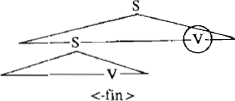
The limitations on term 4 are certainly not a collection of lexical peculiarities though they still escape a revealing description.
Predicate Raising is blocked if the verb in term 4 is
| a) | an inherently reflexive verb, |
| b) | a particle verb [Prep V]V, |
| c) | a verb with a tenseless sentential subject which has undergone Equi-NP- deletion triggered by a dative obejct in the matrix sentence, e.g. gelingen ‘to succeed’, kosten ‘to cost’, amusieren ‘to amuse’. |
Predicate Raising is obligatory if the verb in term 4 is
| a) | a verb with a tenseless sentential subject which does not undergo Equi-NP-deletion, e.g. beginnen ‘to begin’, blieben ‘to remain’, scheinen ‘to seem’, |
| b) | an epistemic model or an auxiliary, supposing that they are granted the deep structure position of the encircled V in (43), |
| c) | a root modal, |
| d) | a verb belonginging to the small class of verbs whose tenseless sentential object should never undergo Equi-NP-deletion, e.g. sehen ‘to see’, hören ‘to hear’, fühlen ‘to feel’, lassen ‘to let’ and a few idiomatic expressions. |
Predicate Raising is optional for the very extensive class of remaning verbs which allow a tenseless sentential objects only if the structure undergoes Equi-NP-deletion. The small class of sehen, which does not allow Equi-NP-deletion will seem to be exceptional until we reach some real understanding of term 4.
The existence of Predicate Raising as a major rule in Dutch-German syntax is strikingly confirmed by the fact that it yields the exact prediction of all synonymous surface distributions related to deep structure (44). A serious counteranalysis should try to predict the same set, preferably retaining a Dutch-German parallel.Ga naar eind7.
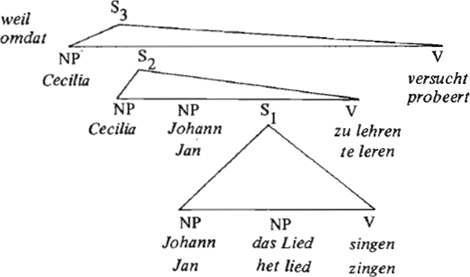
‘because C. tries to teach J. to sing the song’
| (44a) | weil C.J. das Lied [singen zu lehren versucht]V
omdat C.J. het lied [probeert te leren zingen]V |
| (44b) | weil C. versucht [J. das Lied [singen zu lehren] V]S |
| omdat C. probeert [J. het lied [te leren zingen]V]S | |
| (44c) | weil C.J. [zu lehren versucht]y [das Lied zu singen]S |
| omdat C.J. [probeert te leren]V [het lied te zingen]S |
The rules applied on the S2 and the S3 domain respectively are
| for (44a) | Predicate Raising and Predicate Raising | |
| (44b) | Predicate Raising and Extraposition | |
| (44c) | Extraposition | and Predicate Raising |
| (44d) | Extraposition | and Extraposition |
4. Theoretical implications
4.1. The Dutch-German difference
The Dutch row of verbs is a mirror image of the German one, see (30). It is easy to see how this effect follows from a mirror variation between the Dutch and the German rule, see (42) and e.g. (29). In Dutch the S1 verb zingen is Chomsky-adjoined to the right of the S2 verb horen, but in German it is Chomsky-adjoined to the left. The new constituents resulting from this operation may be raised again - in Dutch to the right and in German to the left of the immediately commanding verb. In this way we arrive at the derived constituent (30a) for Dutch and (30b) for German.
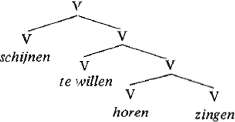

The arguments in the preceding sections purposely avoided reference to the left/right order of the infinitives in order to prove the existence of Predicate Raising for both languages simultaneously. The effect of the rule, however, is immediately obvious in the Dutch surface
string. Former deep structure clause mates indicated in (45) by connecting lines get separated from each other by material from higher situated S-structures.
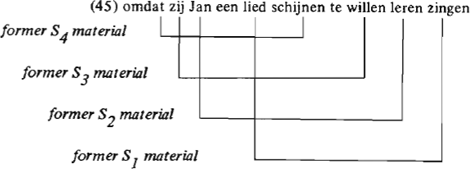
‘because they seem to want to teach J. to sing a sing’
The sentence is completely natural Dutch. Predicate Raising in German effects the same extensive restructuring but this time without correspondent changes in the terminal string. See (29) and (30). The German example contradicts Chomsky's suggestion that transformational operations are string changing rather than tree changing (Chomsky '71, 25).
4.2. Kuroda's Pruning Principle
The pruning of the S-labels as an after effect of Predicate Raising, see section 3.1, confirms that the general theory should allow an S-pruning principle. Kuroda's principle, (referred to in Ross '67, p. 56) explains these prunings in natural way by deleting any S-label whose V has been removed.
The V-raising structures provide an exact falsification of Ross's pruning principle, which deletes any non-branching embedded S (Ross '67, 26). If one assumes a VP-label and if one further assumes that a tenseless S either undergoes Equi-NP-deletion or an NP-raising it is guaranteed that any tenseless S complement which has no initial complementizer becomes non-branching.Ga naar eind8. However, since the variants (44b), (44c) and (44d) show that Extraposition applies to non-branching S-structures, it is inevitable to delay pruning until after Extraposition. But if S-pruning is delayed until after Extraposition, it becomes impossible to prevent the crashingly ungrammatical strings resulting from Extraposition in structures like
| weil ich | { ------------ } | [Peter davon]S[überzeugen | { wollte | } ]V. | |
| (46) | weil ich | { jemanden } | [Peter davon]S[überzeugen | { hörte | } ]V. |
| weil ich | { jemanden } | [Peter davon]S[überzeugen | { half | } ]V. |
| ‘because I | { wanted } | convince Peter of it’. |
| ‘because I | { heard someone } | convince Peter of it’. |
| ‘because I | { helped someone } | convince Peter of it’. |
In short, if Ross' pruning principle were applied before Extraposition, not enough S-labels would be left over, and if it were applied after Extraposition there be too many of them.Ga naar eind9..
4.3. <+aux>as a non-universal
The first to claim that auxiliaries have the status of deep structure main verbs was Ross (Ross '69). One of his arguments was, in fact, German verb distribution. Ross assumes German to be SVO instead of SOV. Since German surface strings keep all verbs in final position, with the exception of the finite verb of the main sentence, a transformation is needed to change the deep SVO into the derived SOV. The transformation to that effect, Verb Final, is suggested in (47a).

‘because J. will have sung the song’
Each main verb in (47a) is moved to the end of its VP. Verb Final seemed an argument for necessarily identifying the position of auxiliaries as main verb positions. If each auxiliary and each main verb marked the beginning of a new VP, one rule of Verb Final would suffice, (see 47b).
However the argument was not too strong. In the first place, Joan Maling showed that the argument for an SVO order in German was inconclusive (Maling '72).Ga naar eind10. In the second place even if German happened to be SVO, Verb Final is perfectly compatible with deep structure auxiliaries. Suppose the rewriting rules introduced auxiliaries and main verb right after the subject. In view of the fact that all verbs have to move into the final position we unite them into one verbal constituent VC. As we know from section 1, this results in a better surface structure anyway. Verb Final, this time defined on VC, would offer no reason to prefer analysis (47b) above analysis (48).
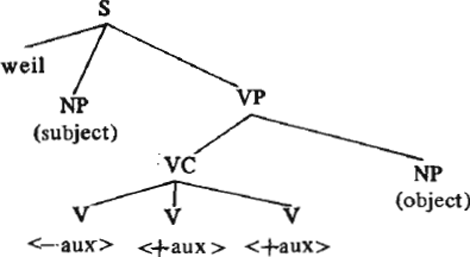
To reject an argument, however, is not to deny its conclusion. It has been shown that Predicate Raising obligatory applies to tenseless sentential subjects. Examples were verbs like scheinen ‘to seem’, beginnen ‘to begin’, bleiben ‘to remain’. This means that auxiliaries can enter the grammar at no cost if we introduce them as intransitive statives with a tenseless sentential subject. On the other hand, the costs of a special deep structure category ‘Aux’ are high and involve:
(i) an extra rewriting rule, (ii) statements of Aux-Aux and Aux-Verb restrictions instead of Verb-Verb restrictions only (Ross '69, 80/81, McCawley '71, 102), (iii) statements of affix distribution parallel to Complementizer Placement (McCawley '71, 97), (iv) irrelevant mention of a category Aux in a number of rules, for example in rules for selection restriction between verb and subject (see Aspects p. 97) and in the Passive transformation, and (v) addition of a sloppyness statement to the rule for S-pronominalization (Ross '69, 82/84) for those cases in which the complement of Aux is the antecedent of a pronoun, e.g.:
| (49) | Bis zum heutigen Tage hat Johann das Lied nur gesungen, wenn Cecilia ihn dazu aufforderte. |
| ‘up till now J. has only sung the song when C. challenged him (to it) challenged him to do so’. | |
Thus it is difficult to see what point there is in a special deep structure position Aux other than complicating the grammar.
The feature<+aux>is not needed to trigger V-Raising (Predicate Raising) in German or VP-Raising (IT-replacement) in English. Both rules can be defined as obligatory for tenseless sentential subjects. The feature <+aux>is only needed for minor rules which are different for each language. The conclusion is that the feature<+aux>is a non universal as there are no universal syntactic phenomena to define it.Ga naar eind11. The claim that <+aux>must be seen as a kind of exception feature entails, of course, no denial of the fact that the combination of irregularity and high text
frequency makes the<+aux>verbs an important group in school grammars designed for the teaching of foreign languages as well as in diachronic inquiry.
4.4. Not structure preserving
Predicate Raising is a clear counter-example to Emonds claim that transformations are necessarily structure preserving (Emonds '70). There are three independent reasons why Predicate Raising is not structure preserving.
The first argument is that if auxiliaries have the deep structure positions of main verbs, no verb can be a deep structure clausemate of another verb. Predicate Raising makes verbs clausemates and for that reason it is not structure preserving.
The second argument is that Predicate Raising can only be captured as a natural process if complement sentences are not yet brought in extraposition. Suppose that transformations were structure preserving so that Extraposition were not a possible transformation then the rewriting rules would have to generate all complement sentences in extraposition. A straightforward application of Predicate Raising would bring the NP constitents of such complements into orphanaged circumstances. For example
| (50) | weil wir Cecilia die Kinder das Lied lehren sehen |
| ‘because we see C. teach the children the song’ |
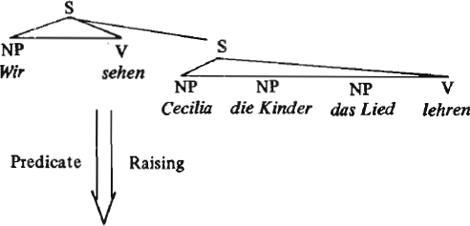

ad hoc provisions for the NP resettlements
The requirement of structure preserving transformations would bring to Predicate Raising the double task of sliding the complement inwards and raising the V. This leads for surface variations like those in (44) to a completely unnatural set of back and forth movements.Ga naar eind12.
A third argument is that the maximum number of non adverb major NP's which are deepstructure clausemates is restricted to three, possibly four. This maximum can always be exceeded by applying Predicate Raising. For example:
| (51) | weil Johann seinem Fotographen eine Mark für die Kopie bezahlte. | ||||
| 1 | 2 | 3 | 4 | ||
| ‘because J. payed his photographer a mark for the copy’ | |||||
This structure can be a complement to the verb sehen ‘see’. After Predicate Raising the result is:
| (52) | weil ich J. seinem Fotographen eine Mark für die Kopie bezahlen sah. | |||||
| 1 | 2 | 3 | 4 | 5 | ||
| ‘because I saw J. pay his photographer a mark for the copy’ | ||||||
This argument should not suggest that there is no limit to the number of NP clausemates. There are limitations. The sentence becomes unacceptable when the NP's come from more than three different S-structures.Ga naar eind13. The point of the argument is that the limitations are not narrow enough to be derived from a structure preserving constraint.
4.5. Lexical Decomposition
It is perhaps better to refer to the syntactic rule of Predicate Raising as V-Raising. Then the question may be raised whether syntactic V-Raising is the same rule as semantic Predicate Raising (see McCawley '68). In the present context this would mean
| (53) | { Predicate Raising / V-Raising | (cyclic) | |
| (53) | { Lexicalization | (cyclic) | |
There are many reasons for regarding Lexicalization as a cyclic process, but it is nevertheless impossible to accept (53). Predicate Raising as compared to V-Raising is too idiosyncratic to be a real transformation.
It is essential for a transformation that its domain can be stated in categorical terms, but the domain of Predicate Raising is related to specific
lexical items. The standard theory took this fact at its face value and constrained the input of the rule. It allowed only certain lexical items to define others by an ad hoc addition of features as <+cause><+inchoative> and the like.
Generative semantics seems to agree that Predicate Raising is constrained by the lexicon in an ad hoc way but it handles the matter by constraining the output of the rule instead of its input. It defines Predicate Raising for a category of predicates and has the results screened by the real lexicon. It is perfectly true that this approach not only lists the actual lexical items but also predicts a certain amount of possible ones. However, the standard theory did the same when it allowed, in principle, the addition of certain features to certain categories of verbs.
A look at V-Raising makes it clear that generative semantics predicts possible lexical items such as:
| (54a) | SEE | |||||||
| (x) | HEAR (y) LEARN (z) | (54c) | be ABLE | |||||
| LET | be ALLOWED | |||||||
| be OBLIGED | to LEARN | |||||||
| be WILLING | ||||||||
| (54b) | HOPE | (54d) | APPEAR | |||||
| BELIEVE | SEEM | (to) LEARN | ||||||
| (x) | ASSURE | (x) LEARN (y) | MAY | |||||
| PROMISE (y) | ||||||||
The absence of these kinds of items in Dutch and German can be expressed by the standard theory in quite a simple way: the respective features to be added to learn do not belong to the Dutch-German system and it may be that some of them do not even belong to any natural grammar, i.e. as features.Ga naar eind14. The same holds for the absence of items based on more than two factors. The standard theory may easily limit the productive power of rules for feature addition.
Generative semantics can not limit the list of possible predicates in the way the standard theory could limit the list of possible features, and of course it cannot limit the recursive power of syntax. Consequently, generative semantics is forced to describe the absence of items like those in (54) and the absence of items based on more than two factors as accidental. This reveals a basic failure of generative semantics. It endows the prelexical rule of Predicate Raising with the full productive power of a real syntactic rule but it subsequently lacks the means to constrain this productivity in an interesting way.
References
| Bach, E. | (1962) | ‘The Order of Elements in a Transformational Grammar of German’, Language 38, 263-269. |
| Bach, E. | ||
| (1971a) | ‘Questions’, Linguistic Inquiry 2, 153-166. | |
| Bach, E. | (1971b) | ‘Syntax since Aspects’, Georgetown University Monograph Series on Languages and Linguistics 24, 1-17. |
| Bierwisch, M. | (1963) | Grammatik des Deutschen Verbs, Berlin (Studia Grammatica II). |
| Bresnan, J. | (1970) | ‘On Complementizers’, Foundations of Language 6, 297-321. |
| Chomsky, N. | (1969) | ‘Deep Structure, Surface Structure and Semantic Interpretation’, paper reproduced by the Linguistics Club, Indiana University. |
| Chomsky, N. | (1970) | ‘Some Empirical Issues in Linguistic Theory’, paper reproduced by the Linguistics Club, Indiana University. |
| Chomsky, N. | (1971) | ‘Conditions on Transformations’, paper reproduced by the Linguistics Club, Indiana University. |
| Emonds, J. | (1970) | Root and Structure Preserving Transformations, doctoral disseration MIT, reproduced by the Linguistics Club, Indiana University. |
| Huybregts, M. | (1973) | ‘On the cyclic nature of sentence stress’ (forthcoming). |
| Jackendoff, R. | (1971) | ‘Gapping and Related Rules’, Linguistic Inquiry 2, 21-35. |
| Lakoff, G. | (1965) | On the Nature of Syntactic Irregularity (Mathematical Linguistics and Automatic Translation, Report NSF - 16), Computation Laboratory of Harvard Univ., Cambridge, Mass. |
| Maling, J. | (1972) | ‘On “Gapping and the Order of Constituents”’, Linguistic Inquiry 3, 101-109. |
| McCawley, J. | (1968) | ‘Lexical Insertion in a Grammar without Deep Structure’, in Papers from the Fourth Regional Meeting of the Chicago Linguistic Society, Chicago. |
| McCawley, J. | (1971) | Tense and Time Reference, in Ch. Fillmore and T. Langendoen, eds., Studies in Linguistics Semantics, New York. |
| Perlmutter, D. | (1971) | Deep and Surface Constraints in Syntax, New York. |
| Ross, J. | (1967) | Constraints on Variables in Syntax, doctoral dissertation MIT, reproduced by the Linguistics Club, Indiana Univ. |
| Ross, J. | (1969) | ‘Auxiliaries as Main Verbs, in W. Todd, ed., Studies in Philosophical Linguistics, Series One, Great Expectations Press, Carbondale, III. |
| Ross. J. | (1972) | ‘Doubling’, Linguistic Inquiry 3, 61-68. |
- eind*
- I would like to thank Mrs. E. Kunne-Ibsch and Peter Sänger for checking the German examples and E. Wayles Browne, Rudolf de Rijk and Henk Schultink for comments and encouragement on an earlier draft of this paper. Most of all I would like to thank MAC. Huybregts for a year full of provocative discussions. Remaining errors are mine.
- eind1.
- I have a slight preference for an SOV order in the deep structure of Dutch and German. This is in no way essential to our arguments which can be easily adapted to an SVO of VSO context. Our preference for SOV is based on the arguments given in Bach ('62) and Bierwisch ('63). We return shortly to the issue in 4.3.
- eind2.
- Arguments will be based on German examples only. Reference to Dutch will be incidentical. The German examples, however, have, without exception, straightforward parallels in Dutch. It is a fact that infinitive clusters which still sound natural in Dutch, already tend to be somewhat strained in German.
- eind3.
- A Gapping may involve discontinuous elements (Jackendoff '71). An example of this which is of specific relevance for our example is given in (i) and (ii).

- eind4.
- It is irrelevant to the argument that there are a few more conditions besides this one. One of the additional conditions forbids moving a quantifier to the right of the constituent which bears the neutral sentence stress. For example the intransitive verbs in (i) and (ii).
The main sentence, however, allows both versions.
(i) weil wir beide schliefen (ii) **weil wir schliefen beide This is a language specific argument for an SOV order in Dutch and German.(iii) Wir beide schliefen (iv) Wir schliefen beide
- eind5.
- S-pronominalization as a deep structure argument is already present in Bierwisch ('63, 127). The argument here is taken from Ross ('69, 85). It differs from an argument: of Lakoff rejected in Chomsky ('69, 46) with the example.
- eind6.
- The German equivalents are
(i) weil wir Benedictine trinken lernen (liqueur) (ii) weil wir Benedictine trinken lernen (girl)
- eind7.
- Synonymous variations like those in (44) were already predicted in Bierwisch ('63) by the generalized transformations GT1 (p. 123), GT2 (p. 132), GTx (p. 134) GT4 (p. 158), GT5 (p. 139), and GT6 (p. 140). The variety of rules relates to the pre-Aspects model of Bierwisch '63). The generalized transformations insert a well prepared string under a marker in the matrix sentence. The marker guarantuees a package of transformational changes, e.g. Equi-NP-deletion or not, kind of complementizer, Extraposition or not, etc. Bierwisch noticed, however, that the S-character of the embedded string got lost if Extraposition did not apply (p. 124 and p. 136). He was also aware of the fact that Extraposition should generalize over tensed and tenseless clauses (p. 143). This brought him in some of his suggestions even close to the idea of a generalized phrasemaker as an empirical issue in syntax (p. 146).
- eind8.
- One might doubt, however, whether it is that easy to get S-structures non-branching. VP-labels or a rule of Object Raising have little or no independent motivation and even if they had, adverbs are bound to cause new troubles for a non-branching condition (see Perlmutter '71, 114).
- eind9.
- The switch from Ross's to Kuroda's principle is not that surprising if one realizes that six of hte eight arguments given by Ross in defense of some pruning principle involved loss of the verb as well as loss of branching. These arguments were consequently compatible with Kuroda's principle. Ross qualified one of the two remaining arguments, a Hungarian construction, as rather unsure, which leaves us with one clear argument against Kuroda's position. This argument, Serbo-Croatian Clitic Placement, can now be reïnterpreted as a case of complementizer substitution (Bresnan '71). An advantage of this reïnterpretation might be the more general hypothesis that clitic movements of the Serbo-Croatian type are only possible in languages which move their clitics into the complementizer constituent, whereas no language where the clitics stay to the right of the subject could ever allow a clitic to leave its infinitival complement. I wonder whether this proposal is compatible with example (173) in Perlmutter (Perlmutter '71, p. 75).
- eind10.
- A recent argument of Bach (Bach '71a) that the rule of WH-movement asks for a VSO order in German, is not strong. One might as well say that WH-movement refers to the complementizer on the left. The most embarrassing aspect of deep structure order is the lack of language specific arguments. Take the following alternative to Bach ('71b), which we offer without being serious about it: all languages are SOV, but some are more SOV than others. Real SOV languages have their complementizers to the right and make no use of the universal rule of V-placement, which brings the final verb in the first or second position of its clause. Languages which have their complementizers to the left can make use of the rule and even do so most of the time.
- eind11.
- It has been suggested (Ross '72, 84) that auxiliaries are semantically universal in the very loose sense that the auxiliaries in one language are often reasonable approximations to the auxiliaries of another language, but this fact, if it is one, seems to be of as little interest as the fact that most languages have a word for father or airplane. Universal semantic categories are bound to reveal trivialities as: the human being takes an interest in family life, means of transportation, etc., whereas syntactic universals or semantic rules referring to syntactic structures may show the way to less obvious facts about the human mind.
- eind12.
- This objection to Emonds proposal would be invalid if Dutch and German were VSO

However, a structure preserving grammar does not allow a Verb Final transformation and must, for that reason, proceed on the assumption that Dutch and German are SOV.
- eind13.
- E.g. in Dutch
The four NP's in (iii) are from the four different S-structures belonging to the four verbs present in the surface structure. The sentence is unacceptable if spoken with neutral stress. The neutral stress is on aria. The four NP's in (i) and (ii) are from three different S-structures and the sentences are acceptable, even if spoken with neutral stress. Note that (ii) has four NP's and four V's just like (iii).
(i) toen ik hem Cecilia de aria hoorde leren zingen ‘when I heard him teaching Cecilia to sing the aria’ (ii) toen ik hem Cecilia de aria kon horen leren zingen ‘when I could hear him teaching C. to sing the song’ (iii) ?? toen ik hem Cecilia de aria liet horen leren zingen 1 2 3 4 1 2 3 4 ‘when I let him hear C, learning to sing the song’
- eind14.
- The projected lexical items
should nog be confused with the morphological possibility of some languages to express in one verb form
[ SEE LEARN ]V x, y, z John sees Peter learn the trick [ HOPE LEARN ]V x, z John hopes to learn the trick [ WANT LEARN ]V x, z John wants to learn the trick There are severe restrictions on such morphological systems, e.g. one would not expectJohn - LEARNS, Ispeaker SEE, - the trick. John - LEARNS, Ispeaker HOPE, - the trick. John - LEARNS INTENTIONALLY- the trick. John - LEARNS. As HEsomeone else SAW, - the trick John - LEARNS, as HEJohn HOPES, - the trick These restrictions seem to me to suggest that morphological mood and tense systems should be processed by feature addition as well.John - LEARNS, as SHE INTENDED, - the trick





